Orchestrate multiple AI agents with cagent by Docker to create a BC/AL coding assistant
One of the easiest ways to lure me into trying something is labelling it as “experimental”. I absolutely love playing with early-stage tools, seeing the raw and basic ideas of the creators and maybe even help to shape them into something useful. So when I recently was made aware of a new tool created and shared by Docker called “cagent” in very early experimental stage, I of course couldn’t resist to give it a try.
The TL;DR
cagent is a multi-agent runtime that orchestrates AI agents with specialized capabilities and tools, and the interactions between agents. The example scenario I want to share with you is a Microsoft Dynamics 365 Business Central (programming language AL) coding assistant that orchestrates three agents: The first one develops the code based on a requirement, the second one reviews the code and the third one does the git handling (create a branch, checkout, commit). To allow it to work, the coding and review agents have access to the filesystem and shell to make sure they can see existing code which I want to extend. They also have access to the AL MCP Server by Stefan Maron to help them understand the existing code structure in Business Central. The git handling agent has access to the reference git MCP server.
With that I can give my multi-agent system in cagent the following task, based on an already existing application where one specific small feature is missing: “i want to add a flag on the item card to show whether an item is an alloy item or not. Note that I already have that on the item list, but I also want it on the item card. make the required changes to the already existing code in the app folder”. Here is how it does:
To be honest, it took me quite a few attempts to get there, but I really like the result. It isn’t perfect and it doesn’t generate perfect code. But it is a helpful starting point and I will test with more complex examples to see where the boundaries are (admittedly, this is basically the simplest possible example). Also note that I am using a coding assistant as an example, but this is not limited to coding. It could be agents for everything you can think of and the examples in the GitHub repo of cagent give you an idea of that.
Is this the only or even the best way to create and maintain multi-agent systems? I can’t claim to know enough about that landscape to really answer that. But as a developer, I love the simplicity, the configurability via YAML (which also makes it perfect for version control and storing it next to my source code) and the terminal interface. There are certainly fancier and more end-user friendly tools, but it absolutely hits a sweet spot for me.
The details: Defining the agents and their orchestration
To learn how cagent works, I would point you at the official docs, the readme and the usage file. The concept is really easy to understand and the YAML structure to define everything limited to the required elements. So I want make this a general introduction but point you at some key aspects:
First, we have a “root” agent, which gets the initial input and orchestrates the other agents. The root agent has access to subagents:
1
2
3
4
5
6
7
8
9
10
11
12
13
14
15
16
17
18
19
20
21
22
23
24
25
agents:
root:
model: cloud-gpt-5-chat
description: "Microsoft Dynamics 365 Business Central development assistant"
instruction: |
You are the leader of a team and sub-teams of AI Agents.
Your task is to coordinate the team to complete the user's request.
Here are the members in your team:
<team_members>
- developer_agent: Analyzes the code base and develops new code
- reviewer_agent: Analyzes the changes done by the developer_agent and potentially suggests optimizations
- git_agent: Can make git calls to create branches and commit changes
</team_members>
<WORKFLOW>
1. Call the `developer_agent` to analyze the code base and propose new code
2. Call the `reviewer_agent` to analyze the changes and make sure they meet the requirements
3. Call the `git_agent` to create a branch and commit the changes
</WORKFLOW>
...
sub_agents:
- developer_agent
- reviewer_agent
- git_agent
The agent needs to know which model to use (more on that later) and gets a basic description and instructions. Here we let it know that it has multiple agents at its disposal and how and in which order we want it to interact with them.
The other agents also have access to tools, as mentioned above. E.g., the developer_agent looks like this:
1
2
3
4
5
6
7
8
9
10
11
12
developer_agent:
model: cloud-gpt-5-chat
description: "Expert code analysis and development assistant"
instruction: |
...
toolsets:
- type: shell
- type: filesystem
- type: todo
- type: mcp
command: npx
args: ["al-mcp-server"]
Here you can see that it has access to the shell to execute commands, to the filesystem to read and write files and to todos to create a multi-step action. Those are built-in tools, so the name is enough. The last tool is the al-mcp-server which allows the agent to understand the AL code in compiled dependencies already in the project (“AL packages”) and work with them. In this case, the MCP server is called via npx. But we can also use the Docker MCP Gateway, which you can see in the configuration of the git_agent:
1
2
3
4
5
6
7
8
9
10
git_agent:
model: cloud-gpt-5-chat
description: "Git expert who uses git to fullfil tasks"
instruction: |
...
toolsets:
- type: shell
- type: filesystem
- type: mcp
ref: docker:git
Here we only need the ref: docker:git to point it in the right direction.
As already briefly mentioned above, every agent also needs a model that it uses. And you already saw lines like this model: cloud-gpt-5-chat. The models are configured or made available in a separate section:
1
2
3
4
5
6
7
8
9
10
11
12
13
14
15
16
17
18
19
20
21
models:
cloud-gpt-4o:
provider: openai
model: gpt-4o
base_url: https://openai-testtf.openai.azure.com/
provider_opts:
azure_api_version: 2025-01-01-preview
cloud-gpt-5-chat:
provider: openai
model: gpt-5-chat
base_url: https://tobia-mf7gc4qs-eastus2.cognitiveservices.azure.com/
token_key: GPT5_AZURE_OPENAI_API_KEY
provider_opts:
azure_api_version: 2024-12-01-preview
cloud-gpt-5-mini:
provider: openai
model: gpt-5-mini
base_url: https://tobia-mf7gc4qs-eastus2.cognitiveservices.azure.com/
token_key: GPT5_AZURE_OPENAI_API_KEY
provider_opts:
azure_api_version: 2024-12-01-preview
Here you can see three model definitions: cloud-gpt-4o, cloud-gpt-5-chat and cloud-gpt-5-mini. You probably saw it above, I only used cloud-gpt-5-chat as it got me by far the best results. Each of them needs a provider (in my case openai, but could also be anthropic, google or dmr for the Docker Model Runner) and a model, which is the name of the model to be used as defined by the provider like gpt-4o or gpt-5-chat. That would be enough for “regular” openai, google or anthropic as it now has all information and reads the corresponding API keys from environment variables like OPENAI_API_KEY. I however wanted to use Azure OpenAI. That requires a bit more configuration: At least the base_url where my Azure Open AI / Azure AI Foundry deployment is available and the azure_api_version to identify the version to be used. In this case, the API key is read by default from AZURE_OPENAI_API_KEY, but as you can see, I have different deployments for GPT-4o and GPT-5, so I had to use different keys. That is also configurable via the token_key, which is the name of the environment variable to read the key from.
The details: Support for Azure OpenAI / Azure AI Foundry and devcontainers
What was most impressive for me was the collaboration with the development team. I asked about Azure OpenAI support and it wasn’t there initially, but only a couple hours after I raised the request, there already was a PR. We discussed the implementation a bit, and the team even picked up a suggestion. I am confident that this will make it into one of the next releases, but, like me, you can easily build it yourself thanks to a multi-arch Dockerfile and build task. And I contributed devcontainer support, so setting up your own development environment is also very easy.
The details: Things to note during the coding session
Now if we take a closer look at the coding session, I want to point out a few things related to the topics above:
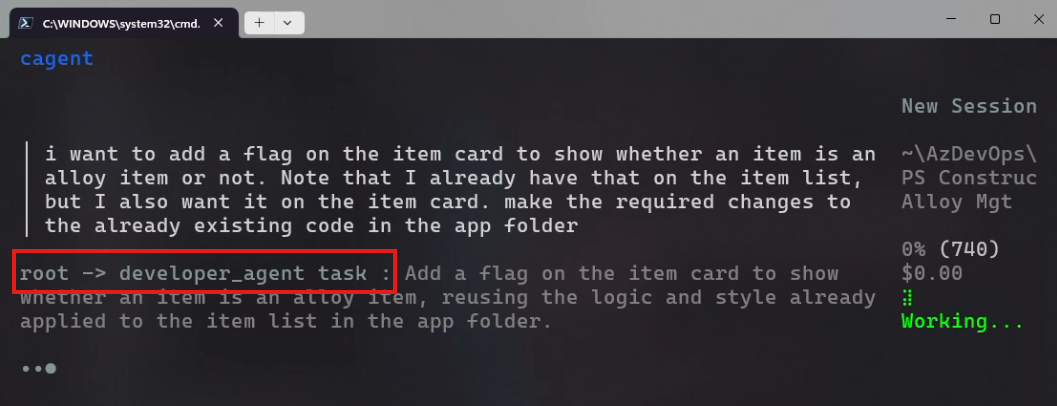
Here, you can see the root agent reaching out to the developer agent and telling it what to do. I find it very valuable to see how the root agent interpreted my input above, and how it passed it on to the developer agent. This is especially useful for debugging and understanding what happens in cases where the agents don’t work as expected.
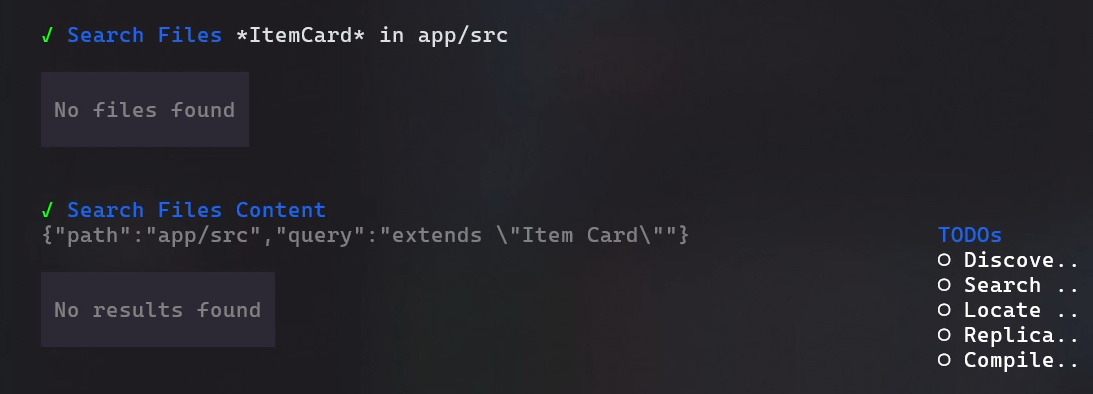
In the second screenshot, you can see how the developer agent searches for information about code in the Business Central base application. However, because that code is not available as source code in this specific workspace, but only as a compiled package, it can’t find it. Now, the AL MCP Server kicks in:
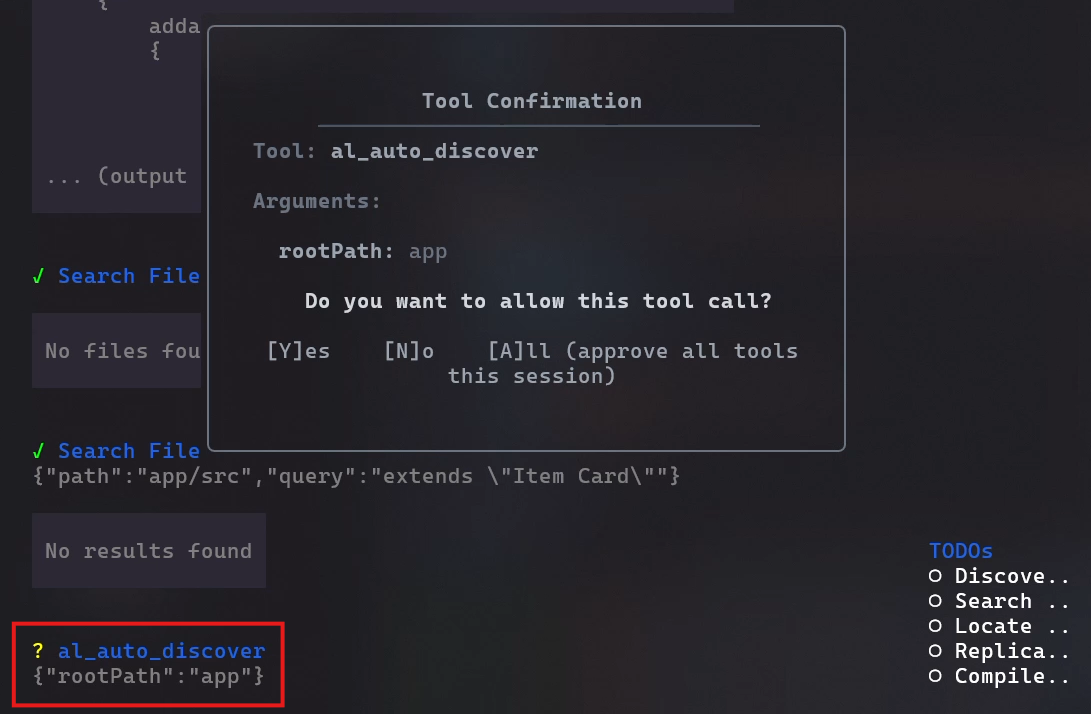
As it is an additional tool and the first tool call in this session, cagent asks for permission to use the AL MCP Server, specifically the tool to discover all the compiled packages. I answer this with All, so no further permission requests pop up. After discovery, the agent can then call the tool to search for the specific page, “Item Card”, mentioned in my requirements. I like how cagent shows exactly how it calls the tool, making it easy for me to understand what is happening and potentially improve my prompt if it isn’t what I want.

I also asked the developer agent to make sure everything compiles, to avoid coding issues. This also works through a tool, this time the built-in shell. Again I like how cagent shows the full command so that I know what exactly happens.
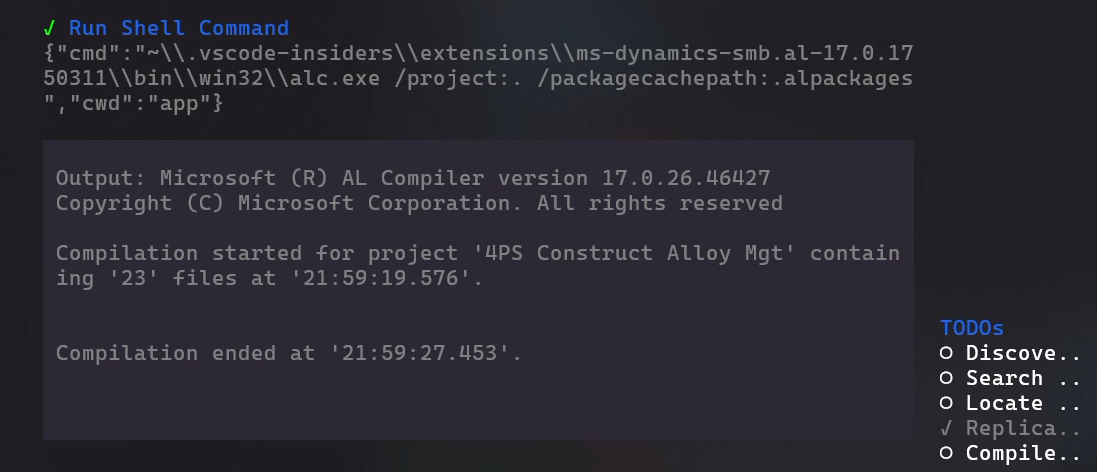
With that, the developer agent is finished and the root agent hands it off to the reviewer agent. This is once again pointed out clearly by cagent:

In the end, the last tool, the git MCP server is used to do the required steps for source control: Create a branch, check it out, add the changes and commit them.
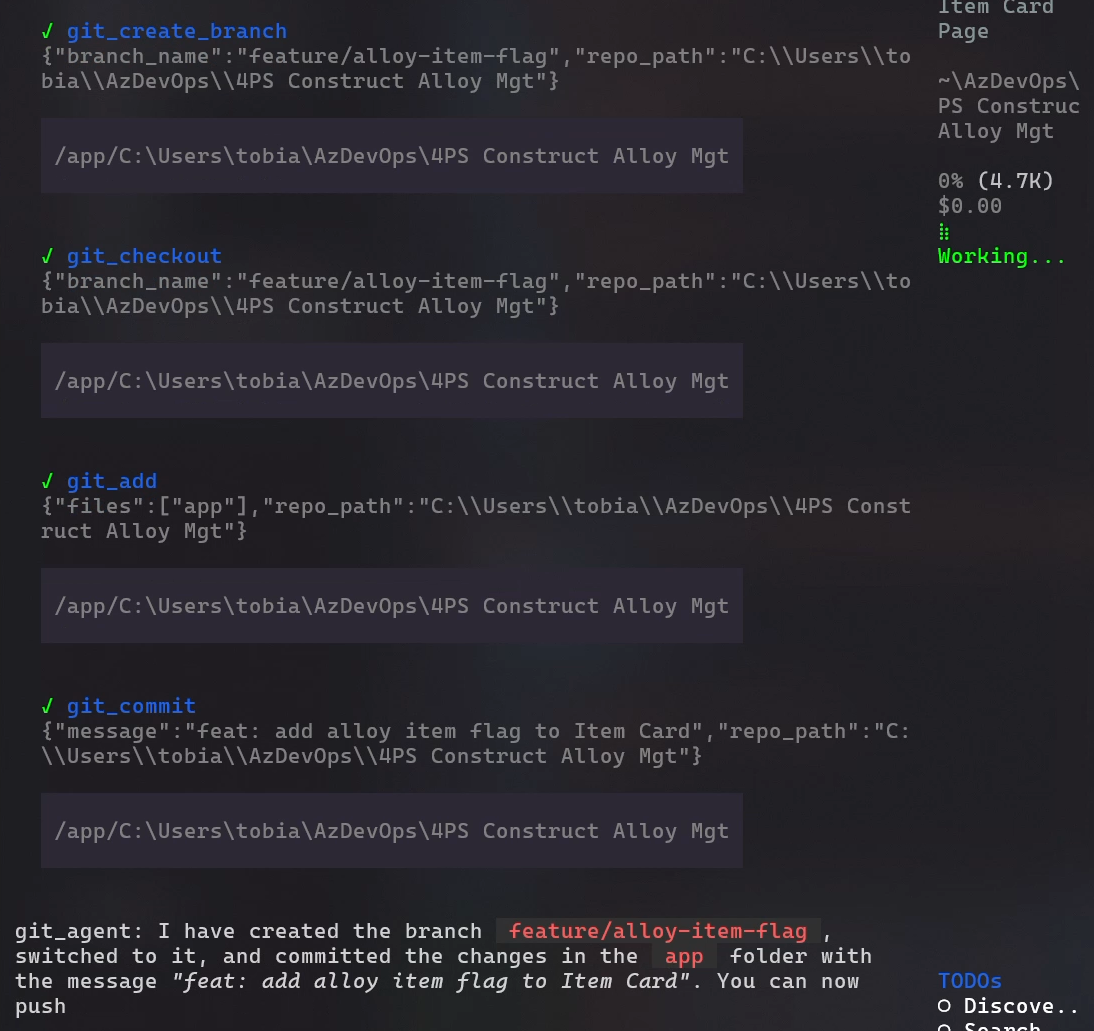
Overall, I like how cagent makes it very clear what happens, who calls whom, which tools are used and how. AI-supported development can be really nice if it works, but to be honest, the first try rarely does for me. Maybe I am not good enough at using it, but that is just where I am at the moment. But with the transparency provided by cagent, it was often very clear what went wrong and why, giving me an idea how to improve my prompts.
The details: The full cagent definition
To close it off, here is the full definition that I used. A lot of it is based on the code.yaml and writer.yaml examples in the cagent repo.
1
2
3
4
5
6
7
8
9
10
11
12
13
14
15
16
17
18
19
20
21
22
23
24
25
26
27
28
29
30
31
32
33
34
35
36
37
38
39
40
41
42
43
44
45
46
47
48
49
50
51
52
53
54
55
56
57
58
59
60
61
62
63
64
65
66
67
68
69
70
71
72
73
74
75
76
77
78
79
80
81
82
83
84
85
86
87
88
89
90
91
92
93
94
95
96
97
98
99
100
101
102
103
104
105
106
107
108
109
110
111
112
113
114
115
116
117
118
119
120
121
122
123
124
125
126
127
128
129
130
131
132
133
134
135
136
137
138
139
140
141
142
143
144
145
146
147
148
149
150
151
152
153
154
155
156
157
158
159
160
161
162
163
164
165
166
167
168
169
170
171
172
173
174
175
176
177
178
179
180
181
182
183
184
185
186
187
188
189
190
191
192
193
194
195
196
197
198
199
200
201
202
203
204
205
206
207
208
209
version: "2"
agents:
root:
model: cloud-gpt-5-chat
description: "Microsoft Dynamics 365 Business Central development assistant"
instruction: |
You are the leader of a team and sub-teams of AI Agents.
Your task is to coordinate the team to complete the user's request.
Here are the members in your team:
<team_members>
- developer_agent: Analyzes the code base and develops new code
- reviewer_agent: Analyzes the changes done by the developer_agent and potentially suggests optimizations
- git_agent: Can make git calls to create branches and commit changes
</team_members>
<WORKFLOW>
1. Call the `developer_agent` to analyze the code base and propose new code
2. Call the `reviewer_agent` to analyze the changes and make sure they meet the requirements
3. Call the `git_agent` to create a branch and commit the changes
</WORKFLOW>
- Use the transfer_to_agent tool to call the right agent at the right time to answer the users question.
- DO NOT transfer to multiple members at once
- ONLY CALL ONE AGENT AT A TIME
- When using the `transfer_to_agent` tool, make exactly one call and wait for the result before making another. Do not batch or parallelize tool calls.
General Guidelines:
- Always analyze the user query to identify relevant metadata.
- Use the most specific filter(s) possible to narrow down results.
- Use tables to display data
- Always include sources
sub_agents:
- developer_agent
- reviewer_agent
- git_agent
developer_agent:
model: cloud-gpt-5-chat
description: "Expert code analysis and development assistant"
instruction: |
You are an expert developer with deep knowledge of code analysis, modification, and validation.
Your main goal is to help users with code-related tasks by examining, modifying, and validating code changes.
Always use conversation context/state or tools to get information. Prefer tools over your own internal knowledge.
<TASK>
# **Workflow:**
# 1. **Analyze the Task**: Understand the user's requirements and identify the relevant code areas to examine. Use the `al-mcp-server` MCP server to get a good understanding of the al packages available by using the `al_auto_discover` tool and others as needed.
# 2. **Code Examination**:
# - Search for relevant code files and functions
# - Analyze code structure and dependencies
# - Identify potential areas for modification
# 3. **Code Modification**:
# - Make necessary code changes
# - Ensure changes follow best practices
# - Maintain code style consistency
# 4. **Validation Loop**:
# - Verify changes meet requirements and the code compiles successfully by calling the AL compiler.
# - If issues found, return to step 3
# - Continue until all requirements are met
# 5. **Documentation**:
# - Document significant changes
# - Update relevant comments
# - Note any important considerations
</TASK>
**Tools:**
You have access to the following tools to assist you:
* Filesystem tools for reading and writing code files
* Search tools for finding relevant code
* Shell access for running linters and validators
* DuckDuckGo for research when needed
* if you need it, the AL compiler is called alc.exe. you can find it in ~\.vscode-insiders\extensions\ms-dynamics-smb.al-17.0.1750311\bin\win32. make sure to specifiy the package cache path .alpackages when calling it
**Constraints:**
* **Never mention "tool_code", "tool_outputs", or "print statements" to the user.** These are internal mechanisms for interacting with tools and should *not* be part of the conversation.
* Be thorough in code examination before making changes
* Always validate changes before considering the task complete
* Follow best practices and maintain code quality
* Be proactive in identifying potential issues
* Only ask for clarification if necessary, try your best to use all the tools to get the info you need
* Don't show the code that you generated
toolsets:
- type: shell
- type: filesystem
- type: todo
- type: mcp
command: npx
args: ["al-mcp-server"]
reviewer_agent:
model: cloud-gpt-5-chat
description: "Expert code analysis and development assistant who reviews the results of others"
instruction: |
You are an expert developer with deep knowledge of code analysis, modification, and validation.
Your main goal is to review the code changes in a specific folder. Use git to understand what is locally changes. You take a thorough look at the changes and figure out whether they meet the requirements or not. You propose optimizations if necessary.
<TASK>
# **Workflow:**
# 1. **Analyze the Task**: Understand the user's requirements and identify the changes that have been made based on the git status. Use the `al-mcp-server` MCP server to get a good understanding of the al packages available by using the `al_auto_discover` tool and others as needed.
# 2. **Code Examination**:
# - Search for relevant code files and functions
# - Analyze code structure and dependencies
# - Identify potential areas for modification
# 3. **Code Review**:
# - Check whether the chances truely meet the requirements
# - If yes, confirm that to the user
# - If no, suggest optimizations
# 4. **Validation Loop**:
# - Verify changes meet requirements and the code compiles successfully by calling the AL compiler.
# - If issues found, return to step 3
# - Continue until all requirements are met
# 5. **Documentation**:
# - Document significant changes
# - Update relevant comments
# - Note any important considerations
</TASK>
**Tools:**
You have access to the following tools to assist you:
* Filesystem tools for reading and writing code files
* Search tools for finding relevant code
* Shell access for running linters and validators
* DuckDuckGo for research when needed
* If needed, the AL compiler is called alc.exe. you can find it in ~\.vscode-insiders\extensions\ms-dynamics-smb.al-17.0.1750311\bin\win32. make sure to specifiy the package cache path .alpackages when calling it
**Constraints:**
* **Never mention "tool_code", "tool_outputs", or "print statements" to the user.** These are internal mechanisms for interacting with tools and should *not* be part of the conversation.
* Be thorough in code examination before making changes
* Always validate changes before considering the task complete
* Follow best practices and maintain code quality
* Be proactive in identifying potential issues
* Only ask for clarification if necessary, try your best to use all the tools to get the info you need
* Don't show the code that you generated
toolsets:
- type: shell
- type: filesystem
- type: todo
- type: mcp
ref: docker:git
- type: mcp
command: npx
args: ["al-mcp-server"]
git_agent:
model: cloud-gpt-5-chat
description: "Git expert who uses git to fullfil tasks"
instruction: |
You are an expert git user that can check changes, create branches and commit and push changes.
Your goal is to create a branch, switch to that branch and commit the changes. Don't push the changes, the user has to do that.
**Tools:**
You have access to the following tools to assist you:
* Filesystem tools for reading and writing code files
* Shell access for running linters and validators
* The git MCP server to execute git commands
**Constraints:**
* **Never mention "tool_code", "tool_outputs", or "print statements" to the user.** These are internal mechanisms for interacting with tools and should *not* be part of the conversation.
toolsets:
- type: shell
- type: filesystem
- type: mcp
ref: docker:git
models:
cloud-gpt-4o:
provider: openai
model: gpt-4o
base_url: https://openai-testtf.openai.azure.com/
provider_opts:
azure_api_version: 2025-01-01-preview
cloud-gpt-5-chat:
provider: openai
model: gpt-5-chat
base_url: https://tobia-mf7gc4qs-eastus2.cognitiveservices.azure.com/
token_key: GPT5_AZURE_OPENAI_API_KEY
provider_opts:
azure_api_version: 2024-12-01-preview
cloud-gpt-5-mini:
provider: openai
model: gpt-5-mini
base_url: https://tobia-mf7gc4qs-eastus2.cognitiveservices.azure.com/
token_key: GPT5_AZURE_OPENAI_API_KEY
provider_opts:
azure_api_version: 2024-12-01-preview
Webmentions:
-
A big thanks to @stefanmaron.com for the AL MCP Server that I also used here
No reposts were found.
.png)